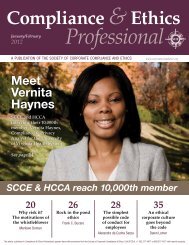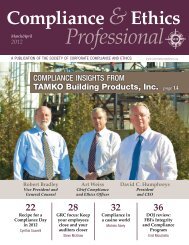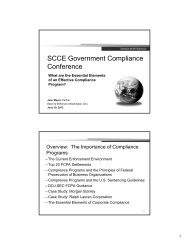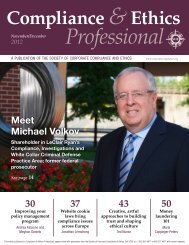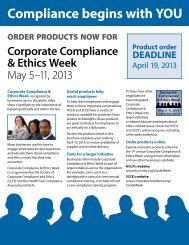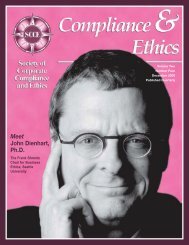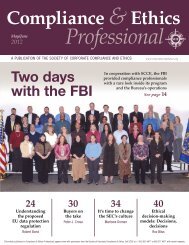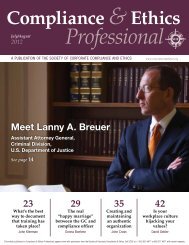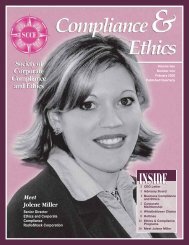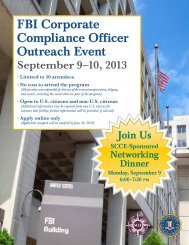Records management: five lessons from the trenches - Society of ...
Records management: five lessons from the trenches - Society of ...
Records management: five lessons from the trenches - Society of ...
Create successful ePaper yourself
Turn your PDF publications into a flip-book with our unique Google optimized e-Paper software.
Volume Three<br />
Number Five<br />
December 2006<br />
Bimonthly<br />
Meet<br />
Hal Degenhardt<br />
Partner, Fulbright & Jaworski<br />
“The Caputo<br />
Opinion”<br />
Judge Ruben Castillo<br />
By Bill Prachar<br />
Join SCCE!<br />
Are you a member <strong>of</strong> a<br />
pr<strong>of</strong>essional compliance<br />
and ethics organization<br />
Page 28<br />
<strong>Society</strong> <strong>of</strong> Corporate Compliance and Ethics • (888) 277-4977 • www.corporatecompliance.org<br />
See pages 24–25<br />
December 2006
Effective records<br />
<strong>management</strong>: Five<br />
<strong>lessons</strong> <strong>from</strong> <strong>the</strong><br />
“<strong>trenches</strong>”<br />
By Ann Straw<br />
Editor’s Note: Ann Straw is <strong>the</strong> Vice<br />
President and Chief Compliance Officer<br />
for Laidlaw International, Inc. Prior to<br />
joining Laidlaw, Ann was Vice President-<br />
Regulatory Affairs and assistant General<br />
Counsel at Corn Products International<br />
Inc, where she was responsible for SEC<br />
reporting, Sarbanes-Oxley and NYSE listing<br />
standards, and o<strong>the</strong>r corporate policies.<br />
<strong>Records</strong> <strong>management</strong> has<br />
become an area <strong>of</strong> increasing<br />
identified risk for companies<br />
since <strong>the</strong> passage <strong>of</strong> <strong>the</strong> Sarbanes-Oxley<br />
Act and, most recently, with <strong>the</strong> implementation<br />
<strong>of</strong> <strong>the</strong> Federal Rules governing<br />
electronic discovery. In addition, <strong>the</strong><br />
world is not going paperless when, in<br />
fact, records are created more easily than<br />
ever before, distributed and forwarded<br />
to larger numbers <strong>of</strong> people, and saved<br />
both electronically and in hard copies by<br />
many recipients. Generation <strong>of</strong> records<br />
has been increasing every year and is<br />
expected to continue. For example,<br />
one study indicates that <strong>the</strong> volume <strong>of</strong><br />
corporate e-mail per day is expected<br />
to increase <strong>from</strong> 31 billion in 2003 to<br />
60 billion in 2006. 1 The end result is<br />
an ever greater volume <strong>of</strong> records that<br />
are being saved unnecessarily or that<br />
are required to be saved but haven’t<br />
been indexed and stored so <strong>the</strong>y can be<br />
searched, reviewed, and produced on a<br />
timely basis in response to a board <strong>of</strong><br />
directors’ inquiry, a government investigation,<br />
or a civil subpoena.<br />
The process <strong>of</strong> finding, retrieving,<br />
reviewing, and producing records is<br />
extremely costly in terms <strong>of</strong> both transaction<br />
time for <strong>management</strong> and <strong>the</strong><br />
dollars involved in <strong>the</strong> process. The failure<br />
to find, retrieve, and produce records<br />
may be extremely costly, if penalties<br />
are imposed as a result. Recognition <strong>of</strong><br />
<strong>the</strong>se risks has caused many companies<br />
to undertake a review <strong>of</strong> existing records<br />
retention policies and procedures. The<br />
ultimate goal <strong>of</strong> such a review is to<br />
implement a records <strong>management</strong> program<br />
that will protect <strong>the</strong> company in a<br />
new era.<br />
In <strong>the</strong> past few years I have been<br />
involved with a variety <strong>of</strong> projects to<br />
implement efficient records <strong>management</strong><br />
programs. Although each <strong>of</strong> <strong>the</strong>se initiatives<br />
is a work in progress, many <strong>lessons</strong><br />
can be learned. This article discusses <strong>five</strong><br />
<strong>lessons</strong> that may be helpful to o<strong>the</strong>rs<br />
who are considering initiating a records<br />
<strong>management</strong> project in <strong>the</strong> future.<br />
Lesson No. 1: Get buy-in <strong>from</strong> <strong>the</strong> business<br />
units <strong>of</strong> your company<br />
In an era <strong>of</strong> increased scrutiny over<br />
spending, most companies are cost<br />
conscious. Successful records <strong>management</strong><br />
programs do not bring dollars to<br />
<strong>the</strong> bottom line in <strong>the</strong> same way that<br />
a successful acquisition or securing a<br />
long-term contract will. This means that<br />
<strong>the</strong> resources necessary to undertake a<br />
records <strong>management</strong> project will not be<br />
Ann Straw<br />
willingly turned over, unless <strong>the</strong>re is buyin<br />
<strong>from</strong> upper <strong>management</strong>, field <strong>management</strong><br />
(where historic records <strong>of</strong>ten are<br />
stored and where many <strong>of</strong> <strong>the</strong> day-to-day<br />
business records are generated), and <strong>the</strong><br />
IT department. At each <strong>of</strong> <strong>the</strong>se levels,<br />
it is important that <strong>the</strong> business sees <strong>the</strong><br />
value <strong>of</strong> <strong>the</strong> undertaking. It isn’t always<br />
obvious.<br />
One effective way to make <strong>the</strong> point<br />
about risk is to describe recent cases<br />
where companies have spent millions<br />
<strong>of</strong> dollars to comply with discovery<br />
requests, or paid fines or settled cases for<br />
failing to produce records or for destroying<br />
records. Examples include Prudential<br />
(a court imposed civil penalties <strong>of</strong> $1 million<br />
for records destruction), Bank <strong>of</strong><br />
America (<strong>the</strong> SEC fined <strong>the</strong> company<br />
$10 million for being slow to produce<br />
evidence and for misleading regulators),<br />
American Express Financial Advisors<br />
(fined $300,000 by <strong>the</strong> National Assoc.<br />
<strong>of</strong> Securities Dealers for failure to<br />
maintain customer account statements<br />
in required format), Murphy Oil USA<br />
v. Fluor Daniel, Inc. ($6.2 million was<br />
spent recovering data <strong>from</strong> 93 backup<br />
tapes), In Re Bristol Myers Squibb (over<br />
$400,000 was spent scanning over 3<br />
million pages <strong>of</strong> documents), Rowe<br />
December 2006<br />
16<br />
<strong>Society</strong> <strong>of</strong> Corporate Compliance and Ethics • (888) 277-4977 • www.corporatecompliance.org
Entertainment v. The William Morris<br />
Agency ($395,944 was spent to restore 8<br />
backup tapes, over $400,000 to restore<br />
47 backup tapes and retrieve email <strong>from</strong><br />
desktop PCs for attorney review), and<br />
<strong>of</strong> course <strong>the</strong> infamous case <strong>of</strong> Arthur<br />
Anderson (involving records destruction<br />
in <strong>the</strong> face <strong>of</strong> an impending government<br />
investigation ). 2<br />
Dollar figures like <strong>the</strong>se help you get <strong>the</strong><br />
point across that records mis<strong>management</strong><br />
is a significant area <strong>of</strong> potential<br />
risk to a company. The need to manage<br />
risk to avoid penalties, or simply to<br />
avoid <strong>the</strong> outrageous transaction costs<br />
that arise in complying with records production<br />
requests, can be conveyed fairly<br />
easily by pointing to <strong>the</strong> misfortune that<br />
o<strong>the</strong>r companies have suffered as a result<br />
<strong>of</strong> not having adequate records <strong>management</strong><br />
programs in place.<br />
But, beyond sending a strong message<br />
regarding risk avoidance, it is crucial<br />
to get buy-in at <strong>the</strong> outset in order to<br />
complete <strong>the</strong> day-to-day drudgery <strong>of</strong> <strong>the</strong><br />
project itself. The drudgery includes:<br />
n Reviewing boxes <strong>of</strong> records stored in<br />
<strong>the</strong> basements, garages, warehouses,<br />
unused <strong>of</strong>fices, or <strong>of</strong>fsite storage areas<br />
<strong>of</strong> <strong>the</strong> company—a time-consuming<br />
and <strong>of</strong>ten dirty task;<br />
n Completing a survey <strong>of</strong> approximately<br />
how many boxes, going back how<br />
many years, and containing what<br />
types <strong>of</strong> records, are being held at<br />
each location in <strong>the</strong> company and<br />
compiling <strong>the</strong> survey results (after<br />
endlessly pursuing those managers<br />
who did not find time to complete<br />
<strong>the</strong> survey within <strong>the</strong> deadline due<br />
to <strong>the</strong> pressure <strong>of</strong> “running <strong>the</strong> business”);<br />
n Determining <strong>the</strong> contents <strong>of</strong> thousands<br />
<strong>of</strong> boxes that are merely labeled,<br />
“HR” or “1998” or “John Doe-<br />
Finance Dept. 2000” or frequently<br />
not labeled at all;<br />
n Discovering which <strong>of</strong> <strong>the</strong> historic<br />
records are being maintained in<br />
duplicate in o<strong>the</strong>r areas, regions, or<br />
corporate <strong>of</strong>fices, and <strong>the</strong>refore, can<br />
be destroyed;<br />
n Creating a common vocabulary so<br />
that personnel around <strong>the</strong> company<br />
are handling similar records in <strong>the</strong><br />
same way. For example, a personnel<br />
file in some parts <strong>of</strong> <strong>the</strong> company<br />
may be broken down into an<br />
“employee file,” “performance file,”<br />
and/or “benefits file” in o<strong>the</strong>r parts<br />
<strong>of</strong> <strong>the</strong> company; a “purchase order”<br />
may be referred to as an “invoice”<br />
in various parts <strong>of</strong> <strong>the</strong> company.<br />
Never assume that personnel who<br />
are reading procedures for maintaining<br />
records will understand that a<br />
personnel file can be <strong>the</strong> same as <strong>the</strong><br />
employee file or that a purchase order<br />
can also mean an invoice);<br />
n Retrieving contracts <strong>from</strong> around <strong>the</strong><br />
company for <strong>the</strong> <strong>of</strong>fsite storage facilities<br />
that house company records and<br />
<strong>the</strong>n reviewing, and if possible, combining<br />
those contracts (if necessary)<br />
to obtain a volume-based discount for<br />
<strong>of</strong>fsite storage;<br />
n Establishing a records retention schedule<br />
that takes into account federal,<br />
state, and municipal requirements for<br />
records retention time periods, and<br />
for multi-national companies, taking<br />
into account foreign law requirements<br />
for records retention; and<br />
n Differentiating between <strong>the</strong> hard copy<br />
records and <strong>the</strong> electronic records<br />
components <strong>of</strong> <strong>the</strong> project and creating<br />
<strong>the</strong> right team to cover each.<br />
All <strong>of</strong> <strong>the</strong> foregoing needs to be done<br />
at <strong>the</strong> outset <strong>of</strong> a records <strong>management</strong><br />
project. Inevitably, you will find that<br />
<strong>the</strong> degree <strong>of</strong> involvement and <strong>the</strong> time<br />
commitment ultimately required by<br />
business managers and administrative<br />
staff is far greater than anticipated, and<br />
<strong>the</strong>refore, buy-in wanes a few months<br />
after <strong>the</strong> project gets underway. It is<br />
important to be realistic about <strong>the</strong> need<br />
for <strong>the</strong>se resources to remain committed<br />
on an ongoing basis. The amount <strong>of</strong><br />
time and energy required to implement<br />
<strong>the</strong> project requires a significant commitment.<br />
Lesson No. 2: Put <strong>the</strong> right team in<br />
place to lead <strong>the</strong> records <strong>management</strong><br />
project<br />
It is logical, initially, to put toge<strong>the</strong>r a<br />
team composed <strong>of</strong> individuals <strong>from</strong> <strong>the</strong><br />
Legal department, <strong>the</strong> Human Resources<br />
department and <strong>the</strong> IT department.<br />
However, it is likely <strong>the</strong> team will<br />
quickly grow to include individuals <strong>from</strong><br />
departments such as Safety and Training<br />
where many records are required to<br />
be maintained for long time periods.<br />
You will probably also want to include<br />
individuals <strong>from</strong> <strong>the</strong> Operations departments<br />
<strong>of</strong> <strong>the</strong> various operating lines<br />
<strong>of</strong> business, <strong>from</strong> <strong>the</strong> Tax department<br />
(which may be notorious for keeping<br />
its records forever), <strong>from</strong> <strong>the</strong> Internal<br />
Audit department (which will likely<br />
be concerned about <strong>the</strong> project <strong>from</strong> a<br />
SOX Section 404 standpoint), and <strong>from</strong><br />
a cross-section <strong>of</strong> your administrative<br />
staff who are ultimately critical to making<br />
a project like records <strong>management</strong><br />
really succeed. The last—and invaluable—addition<br />
to <strong>the</strong> team should be a<br />
Project Manager.<br />
Continued on page 21<br />
<strong>Society</strong> <strong>of</strong> Corporate Compliance and Ethics • (888) 277-4977 • www.corporatecompliance.org<br />
December 2006<br />
17
Five <strong>lessons</strong> <strong>from</strong> <strong>the</strong> “<strong>trenches</strong>” ...continued <strong>from</strong> page 17<br />
Lesson No. 3: Assume <strong>the</strong> Project Will<br />
Be Implemented in Phases<br />
Going into <strong>the</strong> project with an eager<br />
team comprised <strong>of</strong> employees <strong>from</strong><br />
<strong>the</strong> departments noted above, it is not<br />
uncommon to attempt to divide <strong>the</strong><br />
work into <strong>the</strong> various areas <strong>of</strong> expertise.<br />
Often, however, <strong>the</strong> various experts are<br />
put on roughly <strong>the</strong> same timetable for<br />
completion. In o<strong>the</strong>r words, once <strong>the</strong><br />
work is divided, everyone is expected to<br />
move forward in tandem toward completion,<br />
both on <strong>the</strong> hard copy records side<br />
and <strong>the</strong> electronic records side <strong>of</strong> <strong>the</strong><br />
project. This is a recipe for disaster.<br />
Development <strong>of</strong> a records <strong>management</strong><br />
system that works for your company will<br />
inevitably require a phased approach.<br />
For example, many aspects <strong>of</strong> <strong>the</strong> hard<br />
copy records initiative and <strong>the</strong> electronic<br />
records initiative are interdependent<br />
elements <strong>of</strong> <strong>the</strong> project. It isn’t possible<br />
to evaluate outside vendors, programs,<br />
s<strong>of</strong>tware, hardware, or systems improvements<br />
for electronic records <strong>management</strong><br />
without understanding <strong>the</strong> nature <strong>of</strong> <strong>the</strong><br />
records being generated and maintained<br />
in hard copy in <strong>the</strong> field, knowing what<br />
records <strong>the</strong> company would want to continue<br />
maintaining in <strong>the</strong> field as opposed<br />
to centralizing at <strong>the</strong> corporate headquarters,<br />
and especially without knowing<br />
<strong>the</strong> legal and practical (<strong>from</strong> a business<br />
standpoint) retention requirements for<br />
certain types <strong>of</strong> records over a number<br />
<strong>of</strong> years.<br />
Generally (although not always, depending<br />
upon <strong>the</strong> sophistication <strong>of</strong> your current<br />
systems), <strong>the</strong> cost commitment will<br />
be far more significant for <strong>the</strong> electronic<br />
records <strong>management</strong> program than for<br />
<strong>the</strong> hard copy records. In addition, in<br />
many companies, pressure on <strong>the</strong> IT<br />
department to address o<strong>the</strong>r priorities<br />
within <strong>the</strong> company takes precedence<br />
over a records <strong>management</strong> project.<br />
The conclusion reached in <strong>the</strong> companies<br />
where I have been involved is<br />
that <strong>the</strong> hundreds, possibly thousands,<br />
<strong>of</strong> boxes <strong>of</strong> historical records in storage<br />
at various facilities were not going<br />
to be cleaned up, re-boxed to eliminate<br />
vermin, indexed and shipped to a centralized<br />
storage area (or alternatively,<br />
shredded and disposed <strong>of</strong>) overnight. It<br />
becomes obvious after a short time that<br />
grappling with <strong>the</strong> daily generation <strong>of</strong><br />
new records, both hard copies and electronically<br />
stored copies, is imperative. It<br />
is crucial to establish ways to reduce <strong>the</strong><br />
generation <strong>of</strong> new records as a first order<br />
<strong>of</strong> business. Addressing <strong>the</strong> problem <strong>of</strong><br />
how to reduce creation <strong>of</strong> new records<br />
and training employees to follow new<br />
document <strong>management</strong> rules on a sustained<br />
basis becomes an immediate priority<br />
<strong>of</strong> any records <strong>management</strong> project.<br />
O<strong>the</strong>r aspects <strong>of</strong> <strong>the</strong> project can be put<br />
on a longer-term timetable, to be phased<br />
in as <strong>the</strong> project progresses.<br />
Lesson No. 4: Seriously Consider Hiring<br />
A Consultant<br />
Early on, your company may determine<br />
that given <strong>the</strong> availability <strong>of</strong> significant<br />
in-house expertise, <strong>the</strong>re is no need for<br />
hiring a consultant to help organize <strong>the</strong><br />
records <strong>management</strong> project. That may<br />
be a mistake. In many companies, <strong>the</strong><br />
competing demands on people’s time,<br />
budgets, space, and o<strong>the</strong>r resources are<br />
too complex for <strong>the</strong> team to reconcile<br />
without an objective outsider’s help.<br />
Seriously consider hiring a consultant<br />
to help define <strong>the</strong> scope <strong>of</strong> <strong>the</strong> project,<br />
set a realistic budget and timetable, and<br />
conduct interviews covering as many<br />
aspects <strong>of</strong> <strong>the</strong> company’s business as<br />
possible, so that no element <strong>of</strong> record<br />
generation or <strong>management</strong> will be overlooked.<br />
A consultant can <strong>the</strong>n prepare a<br />
report that works as a roadmap for <strong>the</strong><br />
team to move forward on <strong>the</strong> project.<br />
After conducting a series <strong>of</strong> interviews<br />
and seeing presentations <strong>from</strong> several<br />
firms, select <strong>the</strong> consultant who fits <strong>the</strong><br />
culture and values <strong>of</strong> your company,<br />
but also emphasize finding a consultant<br />
who will be practical, accessible, realistic<br />
and candid— all qualities you will value<br />
enormously as <strong>the</strong> project progresses.<br />
A well-chosen consultant will help <strong>the</strong><br />
project team stay on track in many ways.<br />
For example, consider holding weekly<br />
conference calls to follow up on <strong>the</strong><br />
interview process (a representative sampling<br />
<strong>of</strong> employees <strong>from</strong> all lines <strong>of</strong> <strong>the</strong><br />
business should each be interviewed for<br />
approximately half an hour to an hour<br />
to assess needs and current practices) and<br />
consider requiring interim reports that<br />
are concise and to <strong>the</strong> point as progress<br />
markers for <strong>the</strong> project. You will need<br />
ways to measure progress and stay on<br />
your timetable toward completion or <strong>the</strong><br />
project will lose momentum, because <strong>of</strong><br />
its inevitable massive scope.<br />
Lesson No. 5: Be realistic about <strong>the</strong><br />
need to “roll up your sleeves”<br />
A records <strong>management</strong> project may seem<br />
easy to delegate, but it is not easy to<br />
get done <strong>the</strong> way you will want it done<br />
without hands on involvement by team<br />
leaders. As a result, your team should<br />
plan to do site visits to locations where<br />
records are stored in <strong>the</strong> field, such as<br />
<strong>the</strong> garages, attics, and basements <strong>of</strong><br />
your company’s various <strong>of</strong>fices and facilities.<br />
You and your team should tour <strong>the</strong><br />
Continued on page 23<br />
<strong>Society</strong> <strong>of</strong> Corporate Compliance and Ethics • (888) 277-4977 • www.corporatecompliance.org<br />
December 2006<br />
21
Five <strong>lessons</strong> <strong>from</strong> <strong>the</strong> “<strong>trenches</strong>” ...continued <strong>from</strong> page 21<br />
<strong>of</strong>fsite warehouses where outside vendors<br />
have your records stored. You may find<br />
it very helpful to actually cull through<br />
hundreds <strong>of</strong> boxes <strong>of</strong> old documents,<br />
and <strong>the</strong>n make <strong>the</strong> dozens <strong>of</strong> phone calls<br />
necessary to understand <strong>the</strong> contents <strong>of</strong><br />
<strong>the</strong> boxes you have reviewed. Before you<br />
actually start reviewing <strong>the</strong> old records,<br />
you will also need to determine legal<br />
retention requirements and determine<br />
who in your company wants or needs<br />
<strong>the</strong> type <strong>of</strong> records you discover during<br />
your tour.<br />
At this point, it may become critical to<br />
force records <strong>management</strong> issues to <strong>the</strong><br />
top <strong>of</strong> <strong>the</strong> company radar screen so that<br />
realistic and enforceable decisions can be<br />
made regarding ownership <strong>of</strong> <strong>the</strong> records,<br />
location <strong>of</strong> stored records, length <strong>of</strong> time<br />
for records retention, and responsibility<br />
for records <strong>management</strong> decision-making.<br />
By this stage <strong>of</strong> <strong>the</strong> project, you<br />
will need to have disseminated a realistic<br />
records retention schedule (most<br />
records simply don’t need to be kept as<br />
long as people/departments/companies<br />
are inclined to keep <strong>the</strong>m; some documents<br />
aren’t records at all and should not<br />
be kept). Focus on creating a schedule<br />
that is easy to follow and written in a<br />
vocabulary that is commonly understood<br />
in your organization. This may be a far<br />
more difficult task than you may anticipate<br />
up front. Probably <strong>the</strong> most import<br />
outcome <strong>of</strong> a truly hands-on approach,<br />
however, will be that you continuously<br />
reinforce <strong>the</strong> critical buy-in and set <strong>the</strong><br />
tone at <strong>the</strong> top <strong>of</strong> your organization.<br />
Conclusions<br />
Approximately one year into your<br />
company’s records <strong>management</strong> project,<br />
you should have a great and committed<br />
team <strong>of</strong> pr<strong>of</strong>essionals who represent <strong>the</strong><br />
various functional areas <strong>of</strong> <strong>the</strong> business,<br />
and who know a lot more about <strong>the</strong> way<br />
records are generated and stored in <strong>the</strong><br />
company than anyone did at <strong>the</strong> outset.<br />
By <strong>the</strong>n you should also be well aware<br />
how big <strong>the</strong> project is—something you<br />
may not have realized when it began.<br />
And your team should be far more realistic<br />
about <strong>the</strong> time required to implement<br />
a records <strong>management</strong> program<br />
that allows a rational search <strong>of</strong> records<br />
databases, can produce needed records<br />
upon demand, and consistently disposes<br />
<strong>of</strong> unneeded records on a regular schedule.<br />
These may not sound like huge<br />
accomplishments, but once achieved,<br />
your team will be far better prepared<br />
to maintain a records <strong>management</strong><br />
program far into <strong>the</strong> future, one that is<br />
flexible, usable, and ultimately meets<br />
<strong>the</strong> primary objective <strong>of</strong> protecting your<br />
company <strong>from</strong> risk.<br />
1. Source: General Counsel Roundtable research.<br />
2. Sources: Feith Systems and S<strong>of</strong>tware, Inc., “Building an Effective<br />
Compliance & Litigation Support Architecture” and General<br />
Counsel Roundtable research.<br />
<strong>Society</strong> <strong>of</strong> Corporate Compliance and Ethics • (888) 277-4977 • www.corporatecompliance.org<br />
December 2006<br />
23




